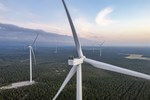News Release from American Clean Power Association (ACP)
Wind Industry Profile of
First Clean Power Annual report shows record U.S. renewables growth and investment
The American Clean Power Association today released its first Clean Power Annual report, which showed wind, utility solar, and battery storage power capacity in the U.S. topped 170 gigawatts (GW), following a record 26 GW of clean energy projects coming online in 2020.
“The Clean Power Annual is a testament to the record growth and investment across the renewable energy industry in the United States today. The energy transition is well underway as we aim to meet important climate targets and create good-paying American jobs,” said Heather Zichal CEO of the American Clean Power Association. “The clean power industry is helping to rebuild the U.S. economy while combating the climate crisis. We hope this report can be a tool and resource as our industry drives innovation and job creating investments in every American state.”
The rapid pace of new clean power installations included 16,836 MW of land-based wind, representing 50 percent of new additions; 8,894 MW of utility-scale solar projects, capturing 26 percent of the market; and 760 MW of battery storage capacity. Combined wind, solar, and battery storage power represent 78 percent of new power installations in 2020.
For comparison in 2010, just 28 percent of new power installations were wind, solar, and battery storage. The amount of new wind capacity in 2020 is more than three times the amount installed in 2010 and the amount of solar installed in 2020 is almost 4,000 percent higher than was installed in 2010, reflecting how cost declines and the growth in the industry have made wind and solar power competitive energy sources. There was only 4 MW of battery storage installed in 2010.
Clean power technologies now deliver 10.7 percent of the nation’s electricity, and current U.S. operating utility wind and solar capacity is capable of powering the equivalent of over 50 million homes.
Clean power strengthens the U.S. economy
Over 415,000 Americans across all 50 states have direct clean energy jobs, and wind turbine technician and solar installer are the country’s first and third fastest growing occupations. Industry momentum combined with supportive policies and regulations could deliver over 1 million clean energy jobs by 2030.
The report also finds clean power projects brought online in 2020 represent roughly $39 billion dollars in investment. Since 2005, total project investment in the clean energy sector is an estimated $334 billion across the U.S.
Clean energy also provided nearly unmatched investment into local communities—last year alone, the clean power industry paid an estimated $1.7 billion in state and local taxes and nearly $800 million in lease payments to landowners across the country.
Growth is continuing across the industry with nearly 90,000 MW of clean energy projects currently underway, representing over $120 billion in new investment.
The report also shows that the unsubsidized cost of energy for wind power has fallen 71% since 2009 and that solar has fallen 90% since 2009. Based on analysis in the report, wind and solar offer the lowest cost of any generation type in most parts of the country.
Business demand for clean power also set a record as corporate buyers announced over 10 GW of new clean power contracts and power purchase agreements in 2020. Corporate buyers (non-utilities) contracted 10,417 MW of clean power capacity, nearly the same amount as utilities (10,854 MW). Non-utility share of contracted clean power capacity reached an all-time high of 46 percent.
The economic impacts from the growing U.S. offshore wind industry are poised to continue as the East Coast experiences a dramatic uptick in growth. Nine gigawatts of offshore wind capacity are in advanced development along the Eastern seaboard, and by the end of 2020 seven states (CT, MD, MA, NJ, NY, RI, and VA) had issued procurements or state targets totaling nearly 30 gigawatts of offshore wind capacity.
Key State Facts
The Clean Power Annual shows that two-thirds of U.S. states operate at least 1 GW of operating wind, utility solar or battery storage capacity.
Texas leads all states with 37,443 MW of cumulative clean power capacity installed, followed by California (20,354 MW), Iowa (11,394 MW), Oklahoma (9,395 MW), and Kansas (7,058 MW).
Texas added the most clean power capacity last year with 6,320 MW, followed by California with 2,193 MW, Florida with 1,267 MW, Iowa with 1,218 MW, and Oklahoma with 1,182 MW.
In 2020, Texas led all states in land-based wind capacity additions with 4,137 MW and utility scale solar capacity additions with 2,044 MW. California led in battery storage additions, with 573 MW.
When it comes to electricity generation, Texas led all states by generating over 100 million MWh of renewable electricity in 2020. However, when it comes to the share of total electricity generated in a state, Iowa led with 57.6% of electricity generated from clean power in 2020. Other top states for clean power generation share include Kansas (43.4%), Oklahoma (35.5%), South Dakota (32.9%), and North Dakota (30.8%).
Environmental Benefits
Wind and solar projects provide significant environmental benefits and long-term health benefits.
During 2020 wind and solar projects avoided 71 million cars’ worth of carbon emissions, or 327 million metric tons of carbon dioxide. Wind and solar projects also avoided 291,000 tons of sulfur dioxide and 245,000 tons of nitrogen oxide, air pollutants that create smog and trigger asthma attacks. These clean air benefits delivered an estimated $16 billion – $41 billion in long-term health benefits in 2020 due to decreased mortality, respiratory issues, and other pollutant-related health impacts.
- Source:
- ACP
- Author:
- Press Office
- Link:
- cleanpower.org/...
- Keywords:
- ACP, association, report, USA, investment, renewable energy, electricity, poer, growth, capacity, homes, economy, state, solar, battery, gigawatts


























